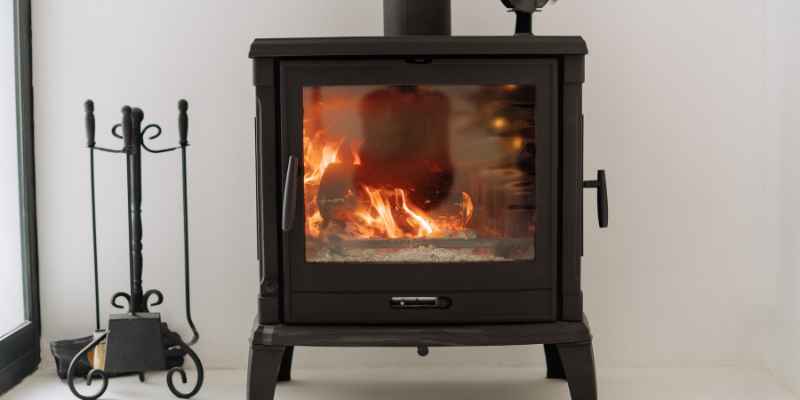How to Convert Gas Fireplace to Wood Burning Stove: Easy Guide
To convert a gas fireplace to a wood-burning stove, you’ll need to install a solid fuel flue and ensure your home has a functioning chimney. Additionally, it’s important to have the chimney inspected by a licensed professional before beginning the conversion process.
Converting a gas fireplace to a wood-burning stove can be an exciting and rewarding project, but it requires careful planning and consideration of several factors. You’ll need to ensure that your home is equipped with a solid fuel flue and a functioning chimney to accommodate the wood-burning stove.
It’s also essential to have the chimney inspected by a licensed professional to verify its safety and suitability for the conversion. By carefully considering these factors and taking the necessary precautions, you can successfully convert your gas fireplace to a wood-burning stove and enjoy the warmth and ambiance of a traditional wood fire in your home.
Initial Considerations For Conversion
Converting a gas fireplace to a wood-burning stove involves several initial considerations, such as assessing the existing chimney and flue type. It’s essential to determine if the gas fireplace is suitable for conversion and to understand the costs and labor involved in the process.
Additionally, ensuring the availability of a functioning chimney is crucial before making the conversion.
Converting a gas fireplace to a wood-burning stove can be an exciting project that adds warmth and charm to your home. However, there are several initial considerations you need to keep in mind before embarking on this conversion. From assessing fireplace compatibility to understanding local building codes, these factors will help ensure a smooth and successful conversion process.
Assessing Fireplace Compatibility
Before converting your gas fireplace to a wood-burning stove, it’s crucial to assess the compatibility of your existing fireplace. Not all gas fireplaces are suitable for conversion, especially factory-made units in newer homes that were never designed to burn wood. To determine if your fireplace is compatible, consider the following:
- Inspect the construction and materials of your fireplace to ensure it can withstand the high temperatures generated by a wood-burning stove.
- Check if your fireplace has a working chimney or flue that is suitable for a wood-burning stove. A solid fuel flue is necessary for the conversion, so if your home has a gas flue, it may not be possible to convert.
- Consider the cost implications of the conversion. If your home lacks a working chimney, installing one can be expensive.
Understanding Local Building Codes
Another crucial aspect to consider when converting a gas fireplace to a wood-burning stove is to understand and comply with local building codes. These codes ensure the safety and proper installation of the stove, protecting you and your home. Here are some key points to keep in mind:
- Research and familiarize yourself with the specific building codes and regulations in your area regarding fireplace conversions.
- Consult with a professional chimney or stove installer who is knowledgeable about local codes and can guide you through the process.
- Ensure that the wood-burning stove you choose meets the safety standards and requirements specified by the local building codes.
By carefully assessing fireplace compatibility and understanding local building codes, you can proceed with confidence in converting your gas fireplace to a wood-burning stove. These initial considerations will help you plan and execute a successful conversion, creating a cozy and inviting atmosphere in your home.
Safety First
Safety should always be the top priority when considering converting a gas fireplace to a wood-burning stove. This process involves various technical and safety considerations to ensure the well-being of your home and family.
Professional Chimney Inspection
Before making any changes, it’s crucial to have a professional chimney inspection to assess the condition of the chimney and flue. This inspection will determine if the chimney is suitable for a wood-burning stove and if any repairs or upgrades are necessary to ensure safety.
Installing Carbon Monoxide Detectors
Carbon monoxide is a potential risk when using wood-burning stoves. Installing carbon monoxide detectors in your home is essential to monitor and alert you to any dangerous levels of this odorless gas. These detectors provide an added layer of safety and peace of mind for your household.
Choosing The Right Wood Stove
If you’ve decided to convert your gas fireplace to a wood-burning stove, congratulations! You’re taking a step towards a more eco-friendly and cost-effective heating solution. However, choosing the right wood stove for your home can be a daunting task. With so many options available in the market, it’s important to consider a few factors before making a purchase.
Size And Heat Output
The first factor to consider when choosing a wood stove is size and heat output. You’ll want to ensure that the stove is the right size for your space and that it can produce enough heat to keep you warm during the winter months. The size of the stove will depend on the size of your room and the amount of insulation you have. A stove that’s too small won’t be able to heat the room effectively, while a stove that’s too large will produce excessive heat and waste energy.
When it comes to heat output, you’ll need to consider the square footage of your space and the desired temperature. A general rule of thumb is that you’ll need 20-25 BTUs per square foot of space. So, if your room is 1,000 square feet, you’ll need a stove that produces 20,000-25,000 BTUs.
Stove Design And Efficiency
The design and efficiency of the wood stove are also important factors to consider. You’ll want to choose a stove that fits the aesthetic of your home and is easy to maintain. The efficiency of the stove will determine how much heat it produces with the amount of wood you burn. A more efficient stove will produce more heat with less wood, which can save you money on fuel costs over time.
When choosing a wood stove, look for models that are EPA certified. These stoves meet the Environmental Protection Agency’s strict emission standards and are more efficient than non-certified models. You can also look for stoves with features like a catalytic converter, which helps to burn off excess gases and particles, or a secondary combustion chamber, which burns off any remaining gases and particles before they’re released into the air.
By considering these factors, you can choose a wood stove that’s the right size, produces enough heat, fits your home’s aesthetic, and is efficient. With the right wood stove, you can enjoy the warmth and comfort of a wood-burning stove while also reducing your carbon footprint and saving money on heating costs.
Preparation Steps
To convert a gas fireplace to a wood burning stove, there are several preparation steps you need to follow. These include removing the log lighter pipe, chimney line, and damper, as well as installing the vent pipe, chimney liner, and surround panel.
It’s important to ensure you have a functioning chimney and solid fuel flue before attempting this conversion.
Converting a gas fireplace to a wood-burning stove can be a great way to update your home and add a rustic touch to your living space. However, before you begin the conversion process, there are several preparation steps you’ll need to take to ensure a successful conversion.
Removing Gas Components
The first step in converting a gas fireplace to a wood-burning stove is to remove all of the gas components from the fireplace. This includes the gas logs, the gas lines, and the gas valve. It’s important to turn off the gas supply to the fireplace before attempting to remove any of these components.
Preparing the Hearth Area
Once the gas components have been removed, it’s time to prepare the hearth area for the wood-burning stove. This involves cleaning the area thoroughly to remove any debris or dust that may have accumulated over time. It’s also important to check the condition of the chimney and ensure that it’s in good working order before installing the wood-burning stove.
To ensure a safe and successful conversion, it’s recommended to hire a professional to inspect the chimney and provide any necessary repairs or upgrades. This will ensure that the chimney is properly vented and able to handle the heat generated by the wood-burning stove.
In conclusion, the preparation steps for converting a gas fireplace to a wood-burning stove are crucial to the success and safety of the project. By following these steps, you can ensure that the conversion is done properly and that you’ll be able to enjoy the warmth and ambiance of a wood-burning stove in your home for years to come.
Ventilation And Flue System

Converting a gas fireplace to a wood-burning stove requires careful consideration of ventilation and flue systems. It’s important to have a solid fuel flue and a functioning chimney to successfully make the conversion. However, not all gas fireplaces can be converted, especially if they were not originally designed to burn wood.
Upgrading The Chimney Flue
When converting a gas fireplace to a wood-burning stove, one of the crucial aspects to consider is the chimney flue. The flue is responsible for carrying the combustion gases out of the house safely. In many cases, the existing gas fireplace flue might not be suitable for a wood-burning stove due to the different requirements for venting. Upgrading the chimney flue is often necessary to ensure proper ventilation and prevent the risk of carbon monoxide buildup.
Proper Venting Techniques
Proper venting is essential for the safe operation of a wood-burning stove. When converting from a gas fireplace, it’s important to ensure that the ventilation system meets the specific requirements for wood-burning stoves. Here are some techniques to consider:
- Installing a stainless steel liner: This helps improve the draft and prevents the buildup of creosote, a highly flammable substance.
- Proper sizing of the flue: The flue size should match the stove’s requirements to ensure efficient venting and prevent smoke leakage.
- Adding a chimney cap: A chimney cap protects the flue from debris and prevents downdrafts.
- Consider the height of the chimney: The chimney should be tall enough to create adequate draft and prevent smoke from entering the living space.
Installation Process
When converting a gas fireplace to a wood-burning stove, the installation process is a crucial step to ensure safety and efficiency. Let’s explore the key steps involved in this process.
Securing The Wood Stove
- Choose a suitable location for the wood stove
- Ensure proper clearance from combustible materials
- Secure the stove to the floor using anchors
Connecting To The Flue
- Inspect the existing flue for compatibility
- Install a solid fuel flue if necessary
- Connect the wood stove to the flue using appropriate connectors
Properly securing the wood stove and connecting it to the flue are essential steps in the conversion process from a gas fireplace to a wood-burning stove. By following these steps carefully, you can enjoy the warmth and ambiance of a wood stove in your home.
Finishing Touches
To convert a gas fireplace to a wood-burning stove, the first step is to carefully remove the gas components and ensure a functioning chimney and solid fuel flue are in place. This conversion project can cost a few hundred dollars plus a few hours of labor, resulting in the warmth and ambiance of a traditional wood-burning stove.
Installing Heat Shields
Aesthetic Enhancements
When converting a gas fireplace to a wood-burning stove, the finishing touches play a crucial role in both functionality and aesthetics.
Installing Heat Shields
Heat shields are essential to protect your walls and surrounding areas from excessive heat. Placing heat shields behind and around the stove can prevent any potential fire hazards.
Aesthetic Enhancements
Enhancing the visual appeal of your wood-burning stove can be achieved through various aesthetic upgrades. Consider adding a decorative mantel or a stylish hearth to complement your interior décor.
Cost Considerations
When converting a gas fireplace to a wood-burning stove, cost considerations play a crucial role in the decision-making process. Understanding the expenses involved and planning your budget accordingly is essential to ensure a smooth conversion process.
Estimating Conversion Expenses
- Cost of materials such as stove, chimney liner, and vent pipe
- Labor costs for installation and retrofitting
- Potential fees for permits and inspections
Budgeting For Maintenance
- Regular chimney cleaning and inspections
- Replacement of stove components as needed
- Annual service and safety checks
Maintenance And Upkeep
Convert your gas fireplace to a wood-burning stove with these simple steps for a cozy and cost-effective heating solution. Ensure your home has a functioning chimney and solid fuel flue, and consider the potential project cost. Enjoy the warmth and ambiance of a wood-burning stove with proper maintenance and upkeep.
Routine Cleaning Procedures
Regularly clean the wood burning stove to ensure optimal performance.
Seasonal Maintenance Checklist
Perform seasonal maintenance tasks to keep the wood burning stove in top condition.
Common Challenges And Solutions

Looking to convert your gas fireplace to a wood burning stove? One common challenge is ensuring your home has a functioning chimney and solid fuel flue. However, with the right setup and professional assistance, this conversion can bring a cozy and cost-effective heating solution to your living space.
Addressing Draft Issues
One common challenge when converting a gas fireplace to a wood-burning stove is addressing draft issues. Draft problems can occur when the airflow in the chimney is not sufficient to properly vent the wood-burning stove. This can result in smoke entering the room or difficulty in starting and maintaining a fire.
To address draft issues, there are a few solutions you can consider:
- Check for obstructions: Inspect the chimney and flue for any blockages or debris that may be hindering proper airflow. Clearing any obstructions can help improve the draft.
- Install a chimney cap: Adding a chimney cap can prevent downdrafts caused by wind, helping to maintain a consistent airflow.
- Adjust the damper: The damper controls the airflow in the chimney. By adjusting the damper position, you can regulate the draft and ensure proper ventilation.
- Consider a draft-inducing fan: If draft issues persist, installing a draft-inducing fan can help improve the airflow in the chimney, enhancing the draft and reducing smoke problems.
Troubleshooting Smoke Problems
Another challenge that may arise when converting a gas fireplace to a wood-burning stove is smoke problems. Smoke can be a nuisance and may indicate improper ventilation or combustion issues.
Here are some troubleshooting steps to address smoke problems:
- Check the damper: Ensure that the damper is fully open when using the wood-burning stove. A partially closed damper can restrict the airflow and cause smoke to back up into the room.
- Inspect the chimney: Look for any leaks or cracks in the chimney that may be allowing smoke to escape into the home. Repair any damages to ensure proper ventilation.
- Use dry and seasoned wood: Wet or unseasoned wood can produce more smoke when burned. Make sure to use dry and properly seasoned wood to minimize smoke production.
- Consider a smoke guard: Installing a smoke guard can help redirect smoke up into the chimney and prevent it from entering the room.
- Consult a professional: If smoke problems persist, it is advisable to consult a professional chimney sweep or technician to evaluate the situation and provide appropriate solutions.
By addressing draft issues and troubleshooting smoke problems, you can overcome common challenges when converting a gas fireplace to a wood-burning stove. Remember to follow safety guidelines and consult professionals when needed to ensure a successful conversion.
Legal And Insurance Implications
Converting a gas fireplace to a wood-burning stove may have legal and insurance implications that need to be considered. It’s essential to check local building codes and regulations before making the switch to ensure compliance with safety standards and insurance requirements.
Consulting with a professional contractor or chimney sweep can help navigate the process and address any potential legal or insurance issues that may arise.
Insurance Policy Adjustments
When converting a gas fireplace to a wood burning stove, it is important to consider the implications it may have on your homeowners insurance policy. Some insurance providers may require adjustments to your policy due to the increased risk of fire associated with wood stoves. It is important to inform your insurance provider of the conversion to ensure that your policy remains valid and to avoid any potential issues in the event of a claim.
Permits And Legal Compliance
Converting a gas fireplace to a wood burning stove may require permits and compliance with local building codes. It is important to check with your local building department to determine if a permit is required and what specific regulations must be followed. Failure to comply with these regulations can result in fines and potential legal issues.
It is important to understand the legal and insurance implications of converting a gas fireplace to a wood burning stove. Failure to comply with regulations or inform your insurance provider can result in serious consequences. It is recommended to consult with a professional contractor to ensure that the conversion is done properly and in compliance with all regulations. By taking the necessary steps, you can enjoy the benefits of a wood burning stove while ensuring that your home remains safe and protected.
Environmental Impact And Efficiency
Converting a gas fireplace to a wood-burning stove is possible, but not all gas fireplaces can be converted. If your gas fireplace was not designed to burn wood, a full replacement may be necessary, which can be costly if you don’t have a working chimney.
Additionally, you’ll need a solid fuel flue and a functioning chimney for the conversion.
Eco-friendly Burning Practices
When it comes to converting your gas fireplace to a wood-burning stove, it’s important to consider the environmental impact of your burning practices. Wood-burning stoves can be a more sustainable option than gas fireplaces, but it’s important to use eco-friendly burning practices to minimize your impact on the environment. This includes using seasoned wood, which burns more efficiently and emits fewer pollutants, and avoiding burning treated or painted wood, which can release harmful chemicals into the air.
Maximizing Energy Efficiency
In addition to being more eco-friendly, wood-burning stoves can also be more energy-efficient than gas fireplaces. One way to maximize energy efficiency is to choose a stove with a high efficiency rating, which will help you get the most heat out of each log you burn. It’s also important to properly maintain your stove, including regularly cleaning the flue and chimney to ensure optimal airflow and combustion.
If you’re considering converting your gas fireplace to a wood-burning stove, it’s important to do your research and choose a stove that meets your needs in terms of both environmental impact and energy efficiency. With the right practices and equipment, you can enjoy the warmth and ambiance of a wood-burning stove while minimizing your impact on the environment and maximizing your energy savings.
Frequently Asked Questions
How Much Does It Cost To Convert A Gas Fireplace To A Wood Burning Stove?
Converting a gas fireplace to a wood-burning stove can be costly, especially if your home lacks a working chimney. It’s possible to convert some gas fireplaces to wood, but not all of them. Factory-made gas fireplaces in newer homes may need to be fully replaced.
Additionally, you will need a solid fuel flue and a functioning chimney for the conversion. The cost can vary, but it could start from a few hundred dollars plus labor.
Can I Turn My Gas Fireplace Into A Wood-burning Fireplace?
Yes, it’s possible to convert some gas fireplaces to wood-burning, but not all. It can be costly if your home lacks a working chimney.
Can I Convert A Gas Stove To A Wood Burning Stove?
Converting a gas stove to a wood burning stove is possible, but it depends on whether you have a solid fuel flue and a functioning chimney. If your home has a gas flue, you cannot convert it to a wood-burning stove.
Additionally, factory-made gas fireplaces in newer homes were not meant to burn wood, so you may need to fully replace it. The cost of conversion can vary depending on the specific situation.
Can You Install A Wood Stove In A Gas Fireplace?
No, it is not possible to install a wood stove in a gas fireplace. Gas flues are not designed to withstand the high temperatures generated by wood burning stoves. It is also important to have a functioning chimney and solid fuel flue for the conversion, which can be costly if your home lacks one.
Conclusion
Converting a gas fireplace to a wood burning stove is an achievable project that requires careful planning and consideration. It’s important to consult with professionals and adhere to safety regulations throughout the process. With the right resources and guidance, this conversion can enhance the ambiance and functionality of your living space.







